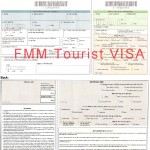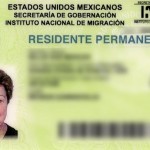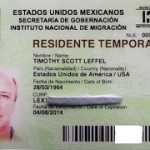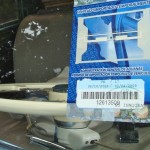Crossing the Border Into Mexico by Car
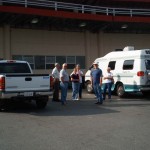 Actually, if you arrive with only a suitcase or two and a few clothes on hangers, perhaps a laptop computer and a pet, it’s pretty easy crossing into Mexico. Try to arrive early enough for the legalities because they take time and there are lots of people crossing back and forth daily. Many border points are open 24/7 but you don’t want to be on the road during the night. Mexico is mountainous and towns may be few and far between. So what exactly does one need to cross the Mexican border by car? This article is aimed at guiding Canadians and Americans on their drive down to Lake Chapala and Ajijic Mexico. It is about a 24 – 48 hour drive from most border crossing points to Lake Chapala, this all depends if you drive straight through or stop at hotels for a rest. Let’s get started on everything you need to start your drive.
Actually, if you arrive with only a suitcase or two and a few clothes on hangers, perhaps a laptop computer and a pet, it’s pretty easy crossing into Mexico. Try to arrive early enough for the legalities because they take time and there are lots of people crossing back and forth daily. Many border points are open 24/7 but you don’t want to be on the road during the night. Mexico is mountainous and towns may be few and far between. So what exactly does one need to cross the Mexican border by car? This article is aimed at guiding Canadians and Americans on their drive down to Lake Chapala and Ajijic Mexico. It is about a 24 – 48 hour drive from most border crossing points to Lake Chapala, this all depends if you drive straight through or stop at hotels for a rest. Let’s get started on everything you need to start your drive.
What do I need to cross the Mexican border by Car?
Unless you have an entry document from a Mexican Consulate for an Visa Permanente or Visa Temporal when you arrive, you will have to pay for an FMM, a visitor’s visa, each of you. Keep the FMM handy because you may have to prove your legal entry at any time, especially at checkpoints. It will be turned in on your way out of the country, and if it is lost, you could be detained or required to pay a fine. If you already possess an Visa Permanente, Visa Temporal or Mexican citizenship, be certain you have copies made in case of loss.
Dual nationality requires proof of status, and when asked at customs, declare the country you are entering as your citizenship, either US or Mexican, if applicable. If you come from a country oversees, there may be different documents required.
- FMM Tourist Visa Mexico
- Mexican Immigrante Permanente
- Mexican None Immigrante Visa Temporal
You wouldn’t even think of crossing a border without your passport, driver’s license, auto registration, insurance and proof of ownership, e.g. title document. Entering Canada, that’s all you need, but entering Mexico, you must also prove, or buy, Mexican car insurance. It is quite reasonable, and you want it because there are country people who are not sophisticated drivers and many highways through mountainous terrain where accidents can happen.
For more, read our Legal and Immigration section
 How to bring in your Pets?
How to bring in your Pets?
That pet needs veterinary documents proving that shots, especially rabies, are up-to-date. Have your pet in a carrier when you process through the border in case they want to open the car door and check the contents. It would be wise to carry a means of providing your pet water and food. Stock up enough for the trip, about three days’ worth.
Read our whole article on bringing in your pets here.
What to expect at “Aduana” Customs?
Tell aduana (customs) where you are headed, for how long, and what goods you are bringing into the country, and where possible, carry receipts if any goods are new, e.g. gifts. The latest guidelines provide $75 USD as duty free, alcohol and tobacco excepted. For more, go online to www.rollybrook.com/how_to_move_to_mexico.
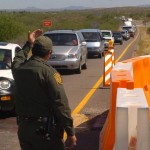 What if you plan to stay and your goods are being shipped? Presumably, you have arranged with a mover. If not, you might want to contact Mexican movers who pick up your goods at the border and bring them to your destination. There are several who are very professional and who know all the paperwork. Professionals north of the border should have already done an inventory of your goods. You will need that in both English and Spanish, including columns for product ID and serial numbers.
What if you plan to stay and your goods are being shipped? Presumably, you have arranged with a mover. If not, you might want to contact Mexican movers who pick up your goods at the border and bring them to your destination. There are several who are very professional and who know all the paperwork. Professionals north of the border should have already done an inventory of your goods. You will need that in both English and Spanish, including columns for product ID and serial numbers.
If you are carrying in only a few choice items, a list is not needed, but if you bring a carload of goods in with you, a list will pass with just the English identification. List product ID and serial numbers of electronics, definitely. Check rollybrook again. That website is kept up-to-date and is quite specific about the details for shipping documentation.
What the authorities want to know when you process through the border is who you are and how you will be able to support yourself while you are in Mexico. There is no social system to fall back on, and if you are depending on credit cards, do have a duplicate copy of the emergency numbers to call from out of the country, as well as the card numbers, names authorized and expiration dates – keep one with your spare clothes in case you lose your wallet. They also want to know that you are not bringing in things like guns, drugs, multiple cars or volumes of music or movies to copy and sell within Mexico.
Getting the Permit for your Car or SUV
Once you have seen the customs people, you will have to process the car, SUV, truck or RV. They will want all those documents that prove the vehicle is yours, that you hold clear title or that you have permission from the bank that holds the car loan, stating that you have permission to take the car into Mexico, and once again, Mexican insurance is a must. They will put a sticker on your windshield which gets turned in when you leave Mexico.
- Mexican Car Permit Sticker
- Banjercito Where you pay your car Permit Sticker at Mexican Border
- Banjercito Where you pay your car Permit Sticker at Mexican Border
Crossing by car is routine once you know the ropes, and the drive from the border to Lake Chapala is eye-opening, beautiful, mountainous, and long. Plan on stopping for the night twice. Stop early, arise early and drive carefully. Taking cuota (toll) roads is worth the cost so stock up on pesos. They often have toll booths placed so the fee is reasonable enough for average Mexicans, about every 100 pesos worth of distance. But this is a good thing. There are food and bathroom facilities and plenty of parking at almost every toll installation. There are often emergency medical facilities. And toll roads include $20,000 pesos insurance in case of injury. Green Angels patrol the highways in trucks well marked, looking for people/vehicles in trouble, no charge to help change a tire, replace a muffler that has fallen off, etc. And if you are on a public road (free or libre), Mexicans driving your way usually come to your aid in a flash.
See our article on roads in Mexico here
What else to expect?
Carry a Spanish-English dictionary, preferably pocket size which will not have every word you look up, but it will be convenient and it will have the majority of words you need. It will help if you look up the nouns you need to use with a local. Let the verbs wait, except that pasado means it happened sometime before now, for instance un hora pasado is an hour ago. That can be very important in an accident.
Another thing Americans and Canadians are not accustomed to is checkpoints where armed military groups ask your destination and check your car for goods that could be illegal, e.g. guns, tropical animals or plants that are protected species. The guards are quite somber because they stand for hours and have many cars and people to check. It is an important job but usually, if they are lucky, quite boring. Please be considerate with them, and they will pass you through quickly.
- Inspecting a car at military check point
- Military Check Point
- Mexican Military Check Point
Driving Mexico is one of my favorite things to do because the land is magnificent and varied, the people about as sweet and naïve as our own countrymen were a generation or two ago when life was quieter, and the beauty all around you is more than worth it. Welcome to Mexico. Bienvenidos a México.
By Kay Davis, Team Writer


